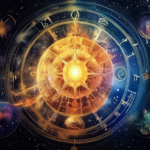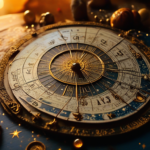Understanding Retrogrades: How Planetary Movements Impact Your Zodiac Sign

The universe, vast and magnificent, resonates with a symphony of celestial bodies moving in harmony. Each planet, as if playing a unique musical instrument, contributes its own rhythm and melody to that cosmic symphony. It’s an orchestration that doesn’t merely unfold before our eyes but influences our very existence on a deeply profound and personal level. This influence can be both powerful and subtle, sometimes appearing as if it is moving backward from our earthly perspective. This phenomenon, known as retrograde motion, forms a crucial part of our astrological journey.
The word “retrograde” in Latin means “backward step,” as the planets, when observed from Earth, appear to be moving in a backward direction. However, this is just an optical illusion because planets can’t move backward in their orbits. This takes place when our planet, Earth, outpaces another planet in its pathway around the sun, creating a sensation much like two trains moving on parallel tracks, where one seems to fall back when the other speeds up.
To understand the effects of retrogrades on our lives, let’s first understand the character of each planet in our celestial symphony. Just like every musician in an orchestra having a distinct role to perform, each planet carries individual significances in astrological terms.
Mercury, the tiny yet swift planet closest to the Sun, is the cosmic messenger. Known for quick thinking, communication, and transportation, it goes retrograde three to four times a year. During this phase, you might experience communication breakdowns, misunderstandings, or technical glitches. The call of Mercury retrograde isn’t to halt your life but to reflect, reassess, and find clarity in your thoughts and words.
Venus, the planet of love, beauty, and wealth, moves into retrograde every 18 months. In this phase, past relationship issues and insecurities may resurface, inviting you to reevaluate your personal relationships and financial matters. Embrace this as a period of grace, using it to harmonize your emotions, and realign your pursuits of pleasure and fulfillment.
Mars, named after the Roman god of war, represents energy, passion, and action. Its retrograde lasts about two months every other year. This phase may bring frustration, delays, or decreased energy. Instead, use this time to reconnect with your inner passion and reassess your motives, being careful not to act out in impatience.

Jupiter, the planet of expansion, abundance, and philosophy, goes retrograde for about four months every year. This time is perfect for spiritual introspection, examining the big picture of your life, where you may feel like exploring new philosophies or taking up a cause that’s close to your heart.
Saturn, the taskmaster of the zodiac, encourages discipline, responsibility, and structure. It moves into retrograde every year for about four and a half months. This time embodies the philosophy “slow and steady wins the race.” It’s a period to reassess your goals, duties, and limitations, to gather strength and wisdom for the journey ahead.
The outer planets, Uranus, Neptune, and Pluto, have longer retrograde cycles, about half the year. These are generational planets affecting broader societal themes. Still, individually they might inspire deep personal transformations, pushing you to question your reality, to break free from illusions, and to uncover hidden aspects of your own self—as if the universe is encouraging you to surface from the depths with pearls of newfound wisdom.
Understanding the significance of each planet and the influence of their retrograde motions can help you navigate these phases with grace and wisdom. Indeed, retrogrades may bring challenges, but aligning with these celestial patterns rather than resisting them is like learning to dance with the rhythm of the cosmic symphony.
This journey of understanding retrogrades brings forth our capacity to pause, reflect, reconnect, and reassess our life’s journey. Every retrograde phase, rather than being viewed with apprehension, can be seen as a cosmic invitation to slow down and realign, and to engage in a dance with the universe itself.
Let us remember that we are stardust, intimately bound to the cosmos. Despite being seemingly small participants in this vast universe, our lives are interwoven with the celestial symphony. By understanding and respecting the influence of planetary movements, we add our own unique rhythm, melody, and dance to the grand cosmic orchestra.
Thus, as we journey through life, mindfully attuned to the celestial rhythms of our friends, the planets, let these influences inspire us just as a musician takes influence from their fellow orchestra members. Together, we create our own harmonious symphony—one that not only sings in tune with the cosmos but also resonates with the song within ourselves. This, dear reader, is the music of life, a journey guided by the celestial gift of astrology.




